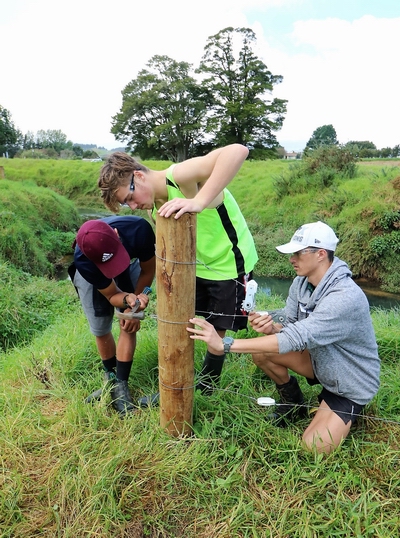A three-year project to improve water quality issues at the iconic Whangarei Falls has reached an important milestone – its first anniversary.
The government announced last year it would contribute $258,000 to the project over three years from its Community Environment Fund, delighting the Northland Regional Council, which is making its own $150,000 cash contribution from its own Environment Fund over the same period.
The three-year project focusses on improving water quality by;
- Contributing funding for riparian fencing and planting
- Contributing to stock troughs where needed to help enable fencing
- Signage at the falls reserve to help educate the community on the values of the water there (including cultural and ecological) and what people can do to help.
Lorna Douglas, the regional council’s Farm Plan Manager, says a total of 18 projects have been funded over the past 12 months.
A file shot of Enviroschools WaiFencing students fencing off part of the Waitaua Stream, in Whangarei’s Hatea Catchment last year.

A file shot of Enviroschools WaiFencing students fencing off part of the Waitaua Stream, in Whangarei's Hatea Catchment last year.
“This funding has already contributed to 4.2km of fencing – worth more than $16,000 – through the regional council fund as well as 1140 plants and installation of 21 stock troughs funded via the Ministry for the Environment.”
Ms Douglas says a broad community group oversees the project, including the regional council, its Whangarei District counterpart, Whitebait Connection, Pehiaweri Marae, Tiki Pride (Tikipunga Community Development Trust) and the Northland District Health Board.
She says most of the funding awarded to date has gone to the Vinegar Hill/Springs Flat areas, but the scheme’s backers are keen to see others in the western part of the catchment (including Three Mile Bush, Dip Rd and Parakiore) also taking advantage of it.
“It may be that those living in the western part of the catchment don’t identify with the falls in quite the same way as others in the catchment – who drive past it regularly – might.”
Ms Douglas says the area just above the 26-metre high Whangarei Falls has been a popular freshwater swimming spot – especially over summer – for many years.
“However, water quality hasn’t met recreational bathing standards roughly a third of the time it’s been tested over a typical summer, and we’ve been working closely with the district council and landowners, and in recent times project partners, to try to improve this.”
Tests show the main sources of bacteria in its water are from either wild birds or stock in the Hatea River catchment, with water quality issues worse after heavy rain.
“Fencing stock away from waterways will not only reduce bacterial levels, it will also lessen the amount of sediment from streambank erosion finding its way into the water, which will improve water clarity too.”
She says stronger rules proposed by the Whangarei Harbour Catchment Group to help improve water quality are also due to come into force within the next several years under the council’s Proposed Regional Plan.
“These will also help, as they will legally require landowners to fence stock out of waterways upstream of a number of identified swimming sites, including the falls.”
She says with just two more years of the extra funding left to run, the scheme’s backers are encouraging as many eligible people as possible to take advantage of it.
“That fund most likely won’t be available after the end of this project, so landowners may have to fund the fencing themselves to be compliant with new regional rules.”
Ms Douglas says anyone interested in checking their potential eligibility for funding via the scheme should contact her at the regional council by phone (09) 470 1105 or email: lornad@nrc.govt.nz
